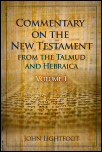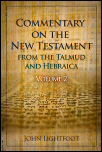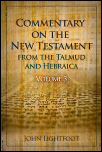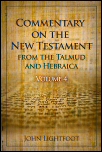A Commentary on the New Testament from the Talmud and Hebraica (4 vols.)
Digital Logos Edition
Overview
John Lightfoot’s Commentary on the New Testament from the Talmud and Hebraica uses rabbinical literature to comment on the text of the New Testament, and to help modern readers understand the textual background from within the framework of Jewish literature. Lightfoot makes full use of Hebrew and Aramaic literature to provide thorough commentary on the New Testament. He uses Jewish sources not only to illuminate textual matters, but also the social and cultural context of the people, places, and events in the New Testament. This important work is meticulously written and has served as a model for synthesizing the New Testament with Jewish literature in the four centuries since its first publication. Lightfoot’s commentary covers the Gospels, Acts, portions of Romans, and 1 Corinthians.
With the Logos Bible Software edition of John Lightfoot’s Commentary on the New Testament from the Talmud and Hebraica, all Scripture references are linked directly to the original language texts and English translations in your library. Double-clicking on any word in any language—Greek, Hebrew, Latin, or Aramaic—automatically opens your lexicons and searches for a match. The entire text of Lightfoot’s Commentary is fully searchable, letting you locate specific verses, topics, or words within the entire commentary. Results from Lightfoot’s Commentary will also appear when you run searches across your entire library, helping you find references, commentary, or other details you wouldn’t find otherwise. That makes the Logos Bible Software edition the premiere edition for students and scholars, and for anyone interested in understanding the New Testament from the context of Jewish literature.
First written in Latin, A Commentary on the New Testament from the Talmud and Hebraica was first published between 1658 and 1674, and reprinted as a whole in 1675, 1686, and 1699. The first English translation was published anonymously in 1684. It was reprinted in 13 volumes between 1822 and 1825 by John Rogers Pitman—an edition popular in the middle part of the nineteenth century. By the 1850s, however, the Pitman edition was becoming “scarce and expensive,” and work on a new edition was begun. The resulting work was published in 1859 by Oxford University. It remains the standard translation of Lightfoot’s work to this day, and has been reprinted numerous times—most recently by Baker in 1979 and Hendrickson in 2004. This edition underlies the electronic edition planned by Logos Bible Software.
This title is included in the following collections
You can save when you purchase this product as part of a collection.
Logos 5 Reformed Bronze Legacy...
$89.99$89.992025 Verbum Researcher Silver
$349.99$279.99Logos 6 Reformed Silver Legacy...
$349.99$349.99Logos 5 Reformed Silver Legacy...
$349.99$349.99
- $849.99$679.99
- $849.99
- $849.99
- $849.99
- $849.99
- $849.99
- $1,499.99$1,049.99
- $1,499.99$1,199.99
- $1,499.99
- $1,499.99
- $1,499.99
- $1,499.99
- $1,499.99
- $2,999.99$2,099.99
- $2,999.99$2,249.99
- $2,999.99
- $2,999.99
- $2,999.99
- $2,999.99
- $2,999.99
- $4,749.99$3,324.99
- $4,749.99$3,562.49
- $4,749.99$3,562.49
- $4,749.99
- $4,749.99
- $4,749.99
- $4,749.99
- $4,749.99
- $4,749.99
- $4,749.99
- $12,102.39$7,299.99
- $10,999.99$8,249.99
- $11,399.99
- $11,399.99
- $11,399.99
- $11,399.99
- $23,999.99$17,999.99
- $21,749.99
- $24,999.99

- Uses the electronic edition of the 1859 Oxford edition—the standard version in print, published by Baker in 1979 and Hendrickson in 2004
- One of the first and most influential commentaries on the New Testament using Talmudic literature
- All Scripture references are linked to the original language texts and English Bible translations in your library
- Double-clicking on any word in any language automatically opens your preferred lexicons and searches for a match
- Title: A Commentary on the New Testament from the Talmud and Hebraica: Matthew–1 Corinthians (Horae Hebraicae et Talmudicae: Hebrew and Talmudical Exercitations upon the Gospels, the Acts, Some Chapters of St. Paul's Epistle to the Romans, and the First Epistle to the Corinthians)
- Author: John Lightfoot
- Publisher: Oxford University Press
- Volumes: 4
- Pages: 1,634

Volume 1: Place Names in the Gospels
- Author: John Lightfoot
- Publisher: Oxford University Press
- Publication Date: 1859
- Pages: 382

Volume 2: Matthew—Mark
- Author: John Lightfoot
- Publisher: Oxford University Press
- Publication Date: 1859
- Pages: 480

Volume 3: Luke—John
- Author: John Lightfoot
- Publisher: Oxford University Press
- Publication Date: 1859
- Pages: 455

Volume 4: Acts—1 Corinthians
- Author: John Lightfoot
- Publisher: Oxford University Press
- Publication Date: 1859
- Pages: 314
John Lightfoot was born in Staffordshire in English on March 29, 1602. He was educated at Christ’s College at Cambridge. From there, he began studying Hebrew under Sir Rowland Cotton, and later became a member of the Westminster Assembly. In 1650, Lightfoot became master of St. Catherine Hall at Cambridge, and in 1654 became the vice-chancellor. Lightfoot died in 1675.
Reviews
13 ratings
Christopher N. Croom
9/18/2019
Priest Zosimios Bukhaidze
11/8/2018
ismael
3/8/2018

Aaron
12/8/2017
Fletcher Hardison
11/28/2017

Maryellen J Lewis
12/8/2016

Juliano Santos de Jesus
9/30/2015

Faithlife User
10/2/2014
steve sackey
4/22/2014

Larry Proffitt (I
11/13/2013